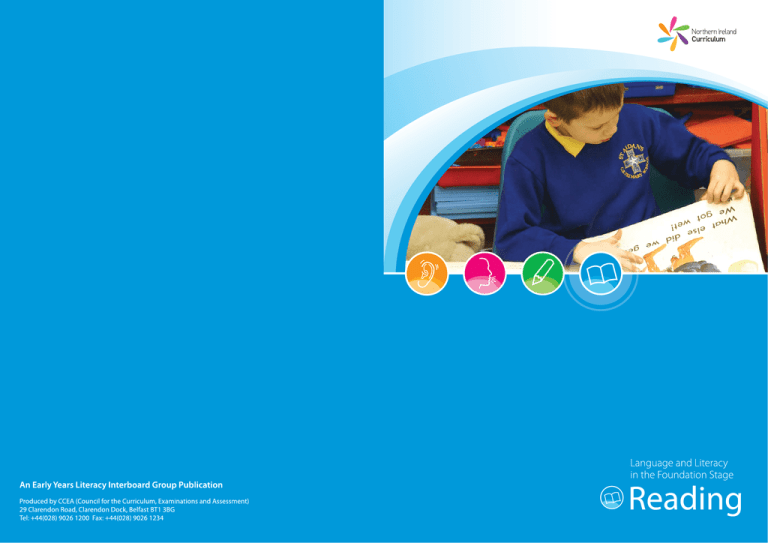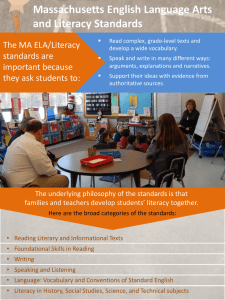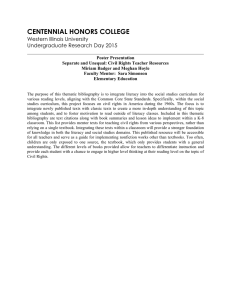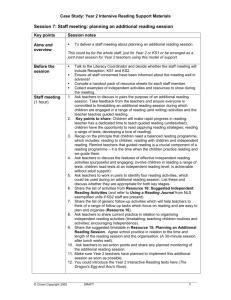Reading
advertisement

Acknowledgements The Early Years Literacy Interboard Group wishes to record its thanks to the following schools for their willing co-operation in the production of this resource. Ballysillan Primary, Belfast; Corran Integrated Primary, Larne; Dickson Primary, Lurgan; Mallusk Primary, Mallusk; Oakwood Integrated Primary, Dunmurry; Saints and Scholars Integrated Primary, Armagh; St Aidan’s Boys’ Primary, Belfast; St Columba’s Primary, Clady; St Malachy’s’ Primary, Bangor; St Mary’s Boys’ Primary, Strabane; and, Sydenham Infants Primary, Belfast. Reading 1 Language and Literacy in the Foundation Stage Introduction Children develop a disposition to read as stories and books are read to them. They also discuss how texts are structured, how to use book language and learn about the rhythm and expression needed for reading aloud. They should see the reader as a role model of reading behaviour. When young children play at reading they imitate what they have seen – turning the pages, looking at the pictures, ‘reading’ the words in that special ‘tone’. As teachers we need to build on and extend this language play so that children develop a love of books and early reading skills. While the central purpose of reading is to gain meaning from print, children also need to be encouraged to develop a curiosity about words, their sounds, patterns and how they are composed. We need to establish a language-rich environment and model and share reading with the children, demonstrating that it is an active part in the process of constructing meaning. 2 Modelled Reading Reading to children should be seen as an essential activity, providing a starting point for developing the thinking child. In the classroom we provide a range of contexts in which to model the importance and enjoyment of reading, for example, reading stories and rhymes, notes and instructions, information texts and children’s writing. ‘Modelled Reading’ is a recognised strategy which allows the teacher to explicitly demonstrate the process of reading by ‘thinking aloud’ about the strategies that are being used to decode words, comprehend meaning and read with fluency and expression. Children participate by listening and observing the expert at work, rather than by contributing suggestions and pursuing points through discussion. The teacher talks through the process step-by-step to show the learner how things are done, for example, making, confirming or changing predictions, re-reading if meaning is unclear or using context to work out a difficult word. Features of Modelled Reading • Each session has a planned focus. • An enlarged text should be clearly visible to all pupils. • A selected range of relevant and motivating fiction and non-fiction texts should be used. • Texts should be within the children’s comprehension level. • Illustrated texts should support and enhance meaning. • Sessions should be short and enjoyable. Reading 3 Language and Literacy in the Foundation Stage Shared Reading We share books with children for many reasons: enjoying stories together, linking with personal experiences, developing imagination and language, learning about books. Listening to stories being read and re-read helps children to gain insights into meaning and story structure. ‘Shared Reading’ has become a recognised strategy for teaching reading in which pupils and teacher read a text together with a focus on a specific aspect. Through experiencing a variety of texts, fiction and non-fiction, children will become aware of the range of strategies required when reading for different purposes. Why Shared Reading? Children will gain: • pleasure; • desire to read; • independence; • knowledge of reading behaviours; • knowledge of reading strategies; • new concepts; • new vocabulary; • knowledge of variety of written forms; • confidence to: – talk – think – share – compare – reflect; • SUCCESS. 4 Features of Shared Reading • Text should be motivating, attractive and chosen with a specific learning outcome in mind. • The children should have access to a text that is slightly beyond their independent level. • Sessions are short, sharp and focussed. • Children are in mixed-ability groups or whole classes. • Reading should be fluent and expressive. • Discussion about the text, illustrations etc. is encouraged. • Children gain insight into decoding and comprehension strategies. • Children have a safe, supportive time to explore and try out reading strategies. • Children should have opportunities to consolidate and transfer learning to other situations through a variety of supported and/or independent reading tasks. Careful observations need to be made of children’s reading behaviours to determine the appropriate teaching focus for each shared session. This will involve observing them, not only during whole-class shared sessions but during small-group sessions and during informal interaction with text, for example, browsing in the book corner or in role-play situations. Reading 5 Language and Literacy in the Foundation Stage The focus may be on: “I think... Developing Understanding: • making links with personal/previous experience, particularly before reading begins; What will happen now? • clarifying meaning by commenting as story/text progresses or pausing to ask pertinent questions; • predicting; • highlighting cause and effect; • building up a picture of characters; Why do you think he did that? • exploring the scene; • exploring the theme/plot; • building a sequence of events. Suggested follow-up tasks: • Sequencing scenes, wall-stories, story-maps, simple time-lines matching pictures or props to characters; • Illustrations, models, dramatisations (including puppet-play); • Story innovations (changing characters, setting, for example, Goldilocks visiting the classroom at break-time). Developing Concepts about Print: • print carries meaning and the meaning does not change; • the difference between picture and print; • left to right orientation – depending on context (stories/lists/speech bubbles/cartoons); • one-to-one correspondence (using a pointer to match each oral to written word); • recognising the difference between words, letters and spaces. 6 Developing Book Handling Skills and ‘Book’ Language: • holding spine, turning pages carefully, ensuring clean hands! • recognising cover, front, back, spine, page, title, author, illustrator. Suggested follow-up tasks: • Browsing in book corner, selecting from book boxes, reading stories to friends or toys; • Using a big book in pairs or small groups. Developing Awareness of Features of Print: • bold print; • size variation; • exclamation marks, capital letters, full-stops and question marks; • speech bubbles and speech marks. Suggested follow-up tasks: • Identifying features in other texts; • Highlighting on acetate sheet; • Adding to shared writing texts. Developing Rhythm and Fluency: • setting a pace; • using intonation and expression; • using punctuation; • reducing teacher input to encourage participation, for example, pausing for children to complete line or insert word. Reading 7 Language and Literacy in the Foundation Stage Suggested follow-up tasks: • Retelling, dramatising stories, and explaining information; • Following taped stories or using animated software, for example, Living Books or Story Websites. Developing Awareness of Structure of Words and Use of Reading Cues: • pointing out target words in text; • looking for words with target sounds; • pulling words out of text for analysis; • highlighting similarities and differences in words; • using pictorial/contextual cues to work out words. Suggested follow-up tasks: • Word-building, word-hunts, highlighting on acetate sheets, simple cloze procedure and matching words. Remember: It is important to provide opportunities to reinforce learning – while many will be incidental, some will be carefully planned, for example, reading captions and notes, using strategies in modelled and shared writing. 8 Organisation Gather the children in the reading area so that they are comfortable and can see the book easily. It is a good idea to develop settling routines such as hand gestures or rhymes. We’re sitting on the carpet. We’re going to read a book. We’re ready on the carpet. Let’s all have a look. Close your eyes, Still your hands Open your eyes, It’s Story Land! It’s reading time, It’s reading time, A story, information or Perhaps it’s a rhyme. Are you ready, are you ready, Are you ready everyone, To join us reading And have some fun. Place the book on a stand so that your hands are free. Have a whiteboard or easel beside you. Introducing the text First reading The nature of introduction depends very much on the type of text and level of background knowledge of the children. You may decide to: • Talk about the cover and encourage the children to predict, for example, “What do you think this book might be about?”, “Why do you think that?” • Remind the class about a similar experience they have had either in school or at home, for example, “Remember how we made shadows in the playground this morning”, “Can you remember your birthday last year?” • Do a picture ‘walk and talk’. Discuss the pictures, using some of the vocabulary and language structures that they will use. Reading 9 Language and Literacy in the Foundation Stage If it is a story book, read it through fluently and expressively so that the children can enjoy the tale. Encourage children to join in if they wish. At the early stages this may be limited to repeated refrains, for example, “I’ll huff and I’ll puff…”. If it is a non-fiction book, you may select a section to read to locate specific information, “Let’s find out what the park is like in Autumn.” You may pause to encourage children to finish lines or insert easily predicted words based on syntax or context. As children acquire more strategies to decode independently, their level of participation should increase. Subsequent readings Focus on your identified learning outcomes. Choose only one or two for each session. Monitor your selection to ensure that all aspects are being addressed: • development of comprehension; • concepts of print; • decoding strategies; • language of books. The same text may be used over several sessions for different purposes. Remember: It is important that your classroom assistant joins each session and models ‘shared reading’ behaviours, particularly in the early stages, when children are learning to listen and respond in a group situation. By modelling paying attention, holding eye-contact, joining in with the reading and responding to questions, she will greatly influence the group. Some children will benefit from revisiting the text and main teaching points in a smaller group, with either the teacher or classroom assistant. Ensure that the text is available so that children may ‘read’ the text by themselves, if they choose to do so. Pre-recorded readings of the story could be provided for use with a listening centre. 10 Emergent Group Reading While children will learn an immense amount about reading during whole-class sessions, it is important that they also have frequent opportunities to read in small groups. Many children need the intimacy of a small group situation to fully grasp the concepts, skills and information being taught. Initially these groups will be randomly selected but as individuals begin to develop more independence, focus groups will emerge. Children who are clearly beginning to apply decoding strategies, can instantly recall some high-frequency words, and talk about how they are making sense of the text will be ready for a more structured ‘Guided’ approach. All children need to hold copies of their own text, to turn pages by themselves, to apply their understanding at their own pace, with the guidance of the teacher. The focus within emergent group sessions is basically the same as within whole-class shared sessions. The teacher moves the session along, highlighting aspects for the group, for example, book-handling skills, discussing decoding strategies, exploring meaning etc. Throughout every session, the main focus is on reading for meaning. At all times, the teacher needs to monitor progress so that appropriate learning points are addressed. It is anticipated that most children will be working in Guided Reading groups within the first term in Year 2. Some children will be ready before this. If a child does not appear to be developing independent reading strategies by the second term in Year 2, the teacher should consult with the Special Needs or Reading Recovery teacher. Reading 11 Language and Literacy in the Foundation Stage When are children ready for Guided Reading ? Children will be able to: • listen attentively while you read to them; • participate spontaneously in shared reading and language experiences; • respond appropriately to language play, poems and jingles that develop awareness of syllabification, rhyme, alliteration, segmenting and blending phonemes; • demonstrate understanding of the concepts of print/book handling skills: – locate title – open front cover – turn pages appropriately – understand the left page comes before the right page – understand that we read print from left to right and top to bottom of page – match spoken word to written word (one-to-one correspondence) – understand the concepts of a word, letter and space; • predict the storyline and some vocabulary; • use pictures to tell story; • use background information and pictures to make connections; • use the meaning of the text to predict words; • use grammatical knowledge to predict words; • have knowledge of letter/sound correspondence; • recognise some familiar words in context; • read some texts independently (95% – 100% word accuracy without help). 12 Guided Reading This is an approach which enables the teacher to support a small group of children in talking, reading and thinking their way purposefully through an unfamiliar text. During guided reading children should consolidate the learning from previous experiences: modelled, shared and group emergent sessions. Why Guided Reading? To help children: • use independent reading strategies successfully; • actively problem solve challenges in the text; • develop positive attitudes; • take risks in a safe, supportive environment; • support each other and work collaboratively; • develop their understanding of the text; • explore themes and ideas, making connections with own experiences; • understand the purpose of the text; • explore the language and features of texts. Organisation of Guided Reading A Guided Reading session will generally last between 10 and 20 minutes. The teacher works with one group while the others are engaged in purposeful activities. In the Guided Reading group, children: • are grouped by ability (see progress indicators in Framework for Literacy Development); • ideally work in groups of no more than eight; • have a copy of the text each. Reading 13 Language and Literacy in the Foundation Stage Selecting a text Texts should be selected to provide opportunities to focus on the planned learning outcome(s), keeping in mind: • interest factor; • curriculum topics; • layout, use of illustrations, etc. All selected texts need to be at an appropriate level for the readers. Texts should be at instructional level, 5–10 errors per 100 words (90% –95% accuracy). Remember: one error in every ten words means that the text is too difficult. Introducing a text Provide support for the readers by: • discussing their prior knowledge of the theme, text type, etc; • helping them predict the story or content; • looking through illustrations (picture flick or walk and talk - do not spoil story lines by over doing this!); • explaining specific language that may cause problems. Remember: judge the level of support needed according to the situation. 14 Reading the text Remind the children of the strategies they can use when tackling unknown words. Make sure they know what to do when finished! The children begin to read the text simultaneously and continue at their own pace. They do this silently (or as silently as possible) while the teacher focuses on one particular reader at a time who reads aloud. This provides an opportunity to prompt and confirm children’s problem-solving attempts and successes. It also allows the teacher to assess how well individuals are coping. The teacher will need to judge which and how many children to work with individually but should engage each child in some way throughout the session. Teachers can guide the children through the text, section by section or let them read a whole text or section uninterrupted. How a text is read will depend on the genre and on the lesson focus, for example, non-fiction-texts will not be read from beginning to end, reading plays will be enhanced if characters are assigned and parts read. After Reading Come back together as a group and focus on particular aspects of the text, for example, theme, characters, punctuation, sentence structure and text layout. Highlight points on a flip-chart/white-board. Reading 15 Language and Literacy in the Foundation Stage Decoding: What does it say? phonetic knowledge awareness of: • letter-sound correspondence • patterns in words • similarities and differences • rhyming and chiming words • syllabification building a sight vocabulary providing exposure to highfrequency words in a variety of contexts picture cues acknowledging relevant detail, relating to own experiences reading on and back helping children make connections fluency, expression modelling or sharing reading with individuals, discussing context, dramatising, providing opportunities to read for an audience The key focus is on developing confidence to use the range of cues available. Comprehension: What does it mean? The key focus is on helping the children make connections so that they can make sense of what they are reading. • Encourage open discussion. • Use a range of open-ended questions. • Model your own thinking, for example, identifying evidence in text. • Encourage children to justify their responses from the text. • Prompt and probe to challenge thinking. • Provide plenty of opportunity for sequencing and predicting. • Use role play and drama to develop empathy. • Explore specific themes, for example, getting lost, making friends. 16 Classroom Management Ensuring rules and routines are clearly established • Use task board or work-grids. • Provide options. The key focus is on encouraging the children to take responsibility for their own learning. Providing appropriate activities • Match activities to the needs of the group or individuals (remember that differentiation can be by task or outcome). • Make sure that children are aware of what is expected by introducing activities carefully: – Model new activities. – Use activities within reading-group sessions until children are familiar with them. • Use open-ended tasks so that children learn to work things out independently. • Plan session carefully. (If you have a classroom assistant ensure that the plan is shared!)





